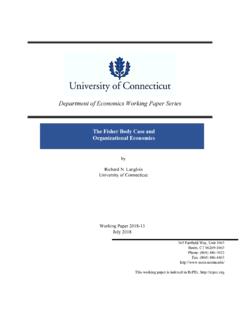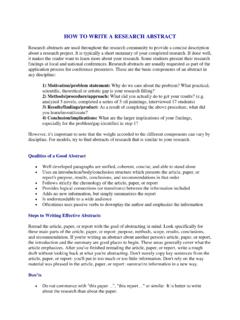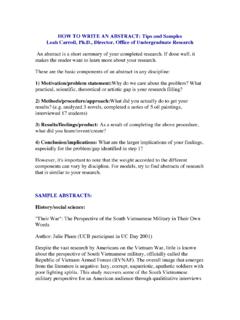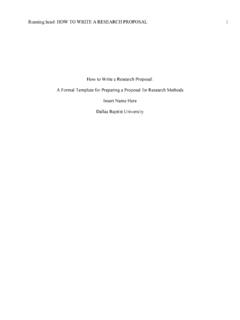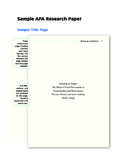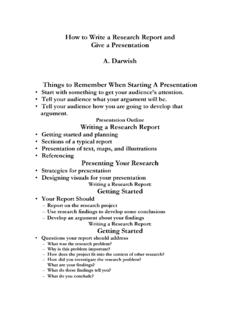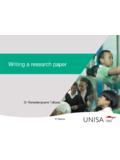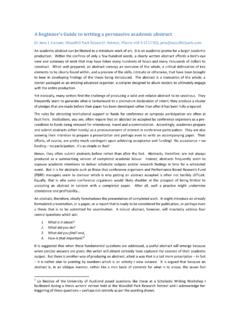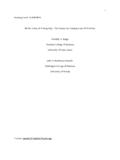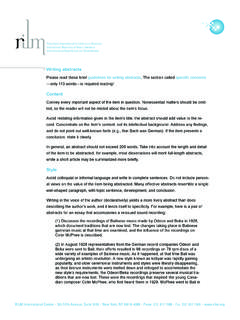Transcription of How to Summarize a Research Article - Central Web Server 2
1 How to Summarize a Research Article Research articles use a standard format to clearly communicate information about an experiment. A Research Article usually has seven major sections: Title, Abstract, Introduction, Method, Results, Discussion, and References. Determine your focus The first thing you should do is to decide why you need to Summarize the Article . If the purpose of the summary is to take notes to later remind yourself about the Article you may want to write a longer summary. However, if the purpose of summarizing the Article is to include it in a paper you are writing, the summary should focus on how the articles relates specifically to your paper.
2 Reading the Article Allow enough time. Before you can write about the Research , you have to understand it. This can often take a lot longer than most people realize. Only when you can clearly explain the study in your own words to someone who hasn t read the Article are you ready to write about it. Scan the Article first. If you try to read a new Article from start to finish, you'll get bogged down in detail. Instead, use your knowledge of APA format to find the main points. Briefly look at each section to identify: the Research question and reason for the study (stated in the Introduction) the hypothesis or hypotheses tested (Introduction) how the hypothesis was tested (Method) the findings (Results, including tables and figures) how the findings were interpreted (Discussion) Underline key sentences or write the key point ( , hypothesis, design) of each paragraph in the margin.
3 Although the abstract can help you to identify the main points, you cannot rely on it exclusively, because it contains very condensed information. Remember to focus on the parts of the Article that are most relevant. Read for depth, read interactively. After you have highlighted the main points, read each section several times. As you read, ask yourself these questions: How does the design of the study address the Research questions? How convincing are the results? Are any of the results surprising? What does this study contribute toward answering the original question?
4 What aspects of the original question remain unanswered? Plagiarism. Plagiarism is always a risk when summarizing someone else s work. To avoid it: Take notes in your own words. Using short notes or summarizing key points in your own words forces you to rewrite the ideas into your own words later. If you find yourself sticking closely to the original language and making only minor changes to the wording, then you probably don't understand the study Writing the Summary Like an abstract in a published Research Article , the purpose of an Article summary is to give the reader a brief overview of the study.
5 To write a good summary, identify what information is important and condense that information for your reader. The better you understand a subject, the easier it is to explain it thoroughly and briefly. Write a first draft. Use the same order as in the Article itself. Adjust the length accordingly depending on the content of your particular Article and how you will be using the summary. State the Research question and explain why it is interesting. State the hypotheses tested. Briefly describe the methods (design, participants, materials, procedure, what was manipulated [independent variables], what was measured [dependent variables], how data were analyzed.)
6 Describe the results. Were they significant? Explain the key implications of the results. Avoid overstating the importance of the findings. The results, and the interpretation of the results, should relate directly to the hypothesis. For the first draft, focus on content, not length (it will probably be too long). Condense later as needed. Try writing about the hypotheses, methods and results first, then about the introduction and discussion last. If you have trouble on one section, leave it for a while and try another. If you are summarizing an Article to include in a paper you are writing it may be sufficient to describe only the results if you give the reader context to understand those results.
7 For example: Smith (2004) found that participants in the motivation group scored higher than those in the control group, confirming that motivational factors play a role in impression formation . This summary not only tells the results but also gives some information on what variables were examined and the outcome of interest. In this case it is very important to introduce the study in a way that the brief summary makes sense in the larger context Edit for completeness and accuracy. Add information for completeness where necessary. More commonly, if you understand the Article , you will need to cut redundant or less important information.
8 Stay focused on the Research question, be concise, and avoid generalities. Edit for style. Write to an intelligent, interested, naive, and slightly lazy audience ( , yourself, your classmates). Expect your readers to be interested, but don't make them struggle to understand you. Include all the important details; don't assume that they are already understood. Eliminate wordiness, including most adverbs ("very", "clearly"). "The results clearly showed that there was no difference between the groups can be shortened to "There was no significant difference between the groups".
9 Use specific, concrete language. Use precise language and cite specific examples to support assertions. Avoid vague references ( "this illustrates" should be "this result illustrates"). Use scientifically accurate language. For example, you cannot "prove" hypotheses (especially with just one study). You "support" or "fail to find support for" them. Rely primarily on paraphrasing, not direct quotes. Direct quotes are seldom used in scientific writing. Instead, paraphrase what you have read. To give due credit for information that you paraphrase, cite the author's last name and the year of the study (Smith, 1982).
10 Re-read what you have written. Ask others to read it to catch things that you ve missed. Adapted from: Summarizing a Research Article 1997-2006, University of Washington

